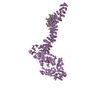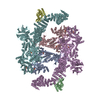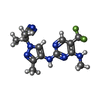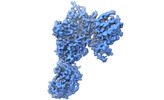+ Open data
Open data
- Basic information
Basic information
| Entry |  | |||||||||
|---|---|---|---|---|---|---|---|---|---|---|
| Title | Cryo-EM structure of LRRK2 bound with type-I inhibitor DNL201 | |||||||||
 Map data Map data | ||||||||||
 Sample Sample |
| |||||||||
 Keywords Keywords | Parkinson's Disease / kinase / activation / HYDROLASE | |||||||||
| Function / homology |  Function and homology information Function and homology informationorganelle / GTP-dependent protein kinase activity / regulation of signal transduction / protein autophosphorylation / cell differentiation / non-specific serine/threonine protein kinase / protein phosphorylation / GTP binding / ATP binding / cytosol Similarity search - Function | |||||||||
| Biological species |  Homo sapiens (human) Homo sapiens (human) | |||||||||
| Method | single particle reconstruction / cryo EM / Resolution: 4.02 Å | |||||||||
 Authors Authors | Sun J / Zhu H | |||||||||
| Funding support |  United States, 1 items United States, 1 items
| |||||||||
 Citation Citation |  Journal: Science / Year: 2023 Journal: Science / Year: 2023Title: Rab29-dependent asymmetrical activation of leucine-rich repeat kinase 2. Authors: Hanwen Zhu / Francesca Tonelli / Martin Turk / Alan Prescott / Dario R Alessi / Ji Sun /   Abstract: Gain-of-function mutations in , which encodes the leucine-rich repeat kinase 2 (LRRK2), are the most common genetic cause of late-onset Parkinson's disease. LRRK2 is recruited to membrane organelles ...Gain-of-function mutations in , which encodes the leucine-rich repeat kinase 2 (LRRK2), are the most common genetic cause of late-onset Parkinson's disease. LRRK2 is recruited to membrane organelles and activated by Rab29, a Rab guanosine triphosphatase encoded in the locus. We present cryo-electron microscopy structures of Rab29-LRRK2 complexes in three oligomeric states, providing key snapshots during LRRK2 recruitment and activation. Rab29 induces an unexpected tetrameric assembly of LRRK2, formed by two kinase-active central protomers and two kinase-inactive peripheral protomers. The central protomers resemble the active-like state trapped by the type I kinase inhibitor DNL201, a compound that underwent a phase 1 clinical trial. Our work reveals the structural mechanism of LRRK2 spatial regulation and provides insights into LRRK2 inhibitor design for Parkinson's disease treatment. | |||||||||
| History |
|
- Structure visualization
Structure visualization
| Supplemental images |
|---|
- Downloads & links
Downloads & links
-EMDB archive
| Map data |  emd_40588.map.gz emd_40588.map.gz | 59.4 MB |  EMDB map data format EMDB map data format | |
|---|---|---|---|---|
| Header (meta data) |  emd-40588-v30.xml emd-40588-v30.xml emd-40588.xml emd-40588.xml | 15.3 KB 15.3 KB | Display Display |  EMDB header EMDB header |
| Images |  emd_40588.png emd_40588.png | 57.8 KB | ||
| Filedesc metadata |  emd-40588.cif.gz emd-40588.cif.gz | 6.2 KB | ||
| Others |  emd_40588_half_map_1.map.gz emd_40588_half_map_1.map.gz emd_40588_half_map_2.map.gz emd_40588_half_map_2.map.gz | 59.4 MB 59.4 MB | ||
| Archive directory |  http://ftp.pdbj.org/pub/emdb/structures/EMD-40588 http://ftp.pdbj.org/pub/emdb/structures/EMD-40588 ftp://ftp.pdbj.org/pub/emdb/structures/EMD-40588 ftp://ftp.pdbj.org/pub/emdb/structures/EMD-40588 | HTTPS FTP |
-Validation report
| Summary document |  emd_40588_validation.pdf.gz emd_40588_validation.pdf.gz | 764.1 KB | Display |  EMDB validaton report EMDB validaton report |
|---|---|---|---|---|
| Full document |  emd_40588_full_validation.pdf.gz emd_40588_full_validation.pdf.gz | 763.7 KB | Display | |
| Data in XML |  emd_40588_validation.xml.gz emd_40588_validation.xml.gz | 12.3 KB | Display | |
| Data in CIF |  emd_40588_validation.cif.gz emd_40588_validation.cif.gz | 14.4 KB | Display | |
| Arichive directory |  https://ftp.pdbj.org/pub/emdb/validation_reports/EMD-40588 https://ftp.pdbj.org/pub/emdb/validation_reports/EMD-40588 ftp://ftp.pdbj.org/pub/emdb/validation_reports/EMD-40588 ftp://ftp.pdbj.org/pub/emdb/validation_reports/EMD-40588 | HTTPS FTP |
-Related structure data
| Related structure data |  8smcMC  8fo2C  8fo8C  8fo9C M: atomic model generated by this map C: citing same article ( |
|---|---|
| Similar structure data | Similarity search - Function & homology  F&H Search F&H Search |
- Links
Links
| EMDB pages |  EMDB (EBI/PDBe) / EMDB (EBI/PDBe) /  EMDataResource EMDataResource |
|---|---|
| Related items in Molecule of the Month |
- Map
Map
| File |  Download / File: emd_40588.map.gz / Format: CCP4 / Size: 64 MB / Type: IMAGE STORED AS FLOATING POINT NUMBER (4 BYTES) Download / File: emd_40588.map.gz / Format: CCP4 / Size: 64 MB / Type: IMAGE STORED AS FLOATING POINT NUMBER (4 BYTES) | ||||||||||||||||||||
|---|---|---|---|---|---|---|---|---|---|---|---|---|---|---|---|---|---|---|---|---|---|
| Voxel size | X=Y=Z: 1.4895 Å | ||||||||||||||||||||
| Density |
| ||||||||||||||||||||
| Symmetry | Space group: 1 | ||||||||||||||||||||
| Details | EMDB XML:
|
-Supplemental data
-Half map: #2
| File | emd_40588_half_map_1.map | ||||||||||||
|---|---|---|---|---|---|---|---|---|---|---|---|---|---|
| Projections & Slices |
| ||||||||||||
| Density Histograms |
-Half map: #1
| File | emd_40588_half_map_2.map | ||||||||||||
|---|---|---|---|---|---|---|---|---|---|---|---|---|---|
| Projections & Slices |
| ||||||||||||
| Density Histograms |
- Sample components
Sample components
-Entire : LRRK2
| Entire | Name: LRRK2 |
|---|---|
| Components |
|
-Supramolecule #1: LRRK2
| Supramolecule | Name: LRRK2 / type: complex / ID: 1 / Parent: 0 / Macromolecule list: #1 |
|---|---|
| Source (natural) | Organism:  Homo sapiens (human) Homo sapiens (human) |
-Macromolecule #1: non-specific serine/threonine protein kinase
| Macromolecule | Name: non-specific serine/threonine protein kinase / type: protein_or_peptide / ID: 1 / Number of copies: 1 / Enantiomer: LEVO |
|---|---|
| Source (natural) | Organism:  Homo sapiens (human) Homo sapiens (human) |
| Molecular weight | Theoretical: 136.843469 KDa |
| Recombinant expression | Organism:  Homo sapiens (human) Homo sapiens (human) |
| Sequence | String: KKAVPYNRMK LMIVGNTGSG KTTLLQQLMK TKKSDLGMQS ATVGIDVKDW PIQIRDKRKR DLVLNVWDFA GREEFYSTHP HFMTQRALY LAVYDLSKGQ AEVDAMKPWL FNIKARASSS PVILVGTHLD VSDEKQRKAC MSKITKELLN KRGFPAIRDY H FVNATEES ...String: KKAVPYNRMK LMIVGNTGSG KTTLLQQLMK TKKSDLGMQS ATVGIDVKDW PIQIRDKRKR DLVLNVWDFA GREEFYSTHP HFMTQRALY LAVYDLSKGQ AEVDAMKPWL FNIKARASSS PVILVGTHLD VSDEKQRKAC MSKITKELLN KRGFPAIRDY H FVNATEES DALAKLRKTI INESLNFKIR DQLVVGQLIP DCYVELEKII LSERKNVPIE FPVIDRKRLL QLVRENQLQL DE NELPHAV HFLNESGVLL HFQDPALQLS DLYFVEPKWL CKIMAQILTV KVEGCPKHPK GIISRRDVEK FLSKKRKFPK NYM TQYFKL LEKFQIALPI GEEYLLVPSS LSDHRPVIEL PHCENSEIII RLYEMPYFPM GFWSRLINRL LEISPYMLSG RERA LRPNR RYWRQGIYLN WSPEAYCLVG SEVLDNHPES FLKITVPSCR KGCILLGQVV DHIDSLMEEW FPGLLEIDIC GEGET LLKK WALYSFNDGE EHQKILLDDL MKKAEEGDLL VNPDQPRLTI PISQIAPDLI LADLPRNIML NNDELEFEQA PEFLLG DGS FGSVYRAAYE GEEVAVKIFN KHTSLRLLRQ ELVVLCHLHH PSLISLLAAG IRPRMLVMEL ASKGSLDRLL QQDKASL TR TLQHRIALHV ADGLRYLHSA MIIYRDLKPH NVLLFTLYPN AAIIAKIADY GIAQYCCRMG IKTSEGTPGF RAPEVARG N VIYNQQADVY SFGLLLYDIL TTGGRIVEGL KFPNEFDELE IQGKLPDPVK EYGCAPWPMV EKLIKQCLKE NPQERPTSA QVFDILNSAE LVCLTRRILL PKNVIVECMV ATHHNSRNAS IWLGCGHTDR GQLSFLDLNT EGYTSEEVAD SRILCLALVH LPVEKESWI VSGTQSGTLL VINTEDGKKR HTLEKMTDSV TCLYCNSFSK QSKQKNFLLV GTADGKLAIF EDKTVKLKGA A PLKILNIG NVSTPLMCLS ESTNSTERNV MWGGCGTKIF SFSNDFTIQK LIETRTSQLF SYAAFSDSNI ITVVVDTALY IA KQNSPVV EVWDKKTEKL CGLIDCVHFL REVTVKENKE SKHKTSYSGR VKTLCLQKNT ALWIGTGGGH ILLLDLSTRR LIR VIYNFC NSVRVMMTAQ LGSLKNVMLV LGYNRKNTEG TQKQKEIQSC LTVWDINLPH EVQNLEKHIE VRKELAEKMR RTSV E UniProtKB: non-specific serine/threonine protein kinase |
-Macromolecule #2: GUANOSINE-5'-DIPHOSPHATE
| Macromolecule | Name: GUANOSINE-5'-DIPHOSPHATE / type: ligand / ID: 2 / Number of copies: 1 / Formula: GDP |
|---|---|
| Molecular weight | Theoretical: 443.201 Da |
| Chemical component information |  ChemComp-GDP: |
-Macromolecule #3: 2-methyl-2-(3-methyl-4-{[4-(methylamino)-5-(trifluoromethyl)pyrim...
| Macromolecule | Name: 2-methyl-2-(3-methyl-4-{[4-(methylamino)-5-(trifluoromethyl)pyrimidin-2-yl]amino}-1H-pyrazol-1-yl)propanenitrile type: ligand / ID: 3 / Number of copies: 1 / Formula: TVT |
|---|---|
| Molecular weight | Theoretical: 339.319 Da |
| Chemical component information |  ChemComp-TVT: |
-Experimental details
-Structure determination
| Method | cryo EM |
|---|---|
 Processing Processing | single particle reconstruction |
| Aggregation state | particle |
- Sample preparation
Sample preparation
| Buffer | pH: 8 |
|---|---|
| Vitrification | Cryogen name: ETHANE |
- Electron microscopy
Electron microscopy
| Microscope | FEI TITAN KRIOS |
|---|---|
| Image recording | Film or detector model: GATAN K3 (6k x 4k) / Average electron dose: 1.0 e/Å2 |
| Electron beam | Acceleration voltage: 300 kV / Electron source:  FIELD EMISSION GUN FIELD EMISSION GUN |
| Electron optics | Illumination mode: FLOOD BEAM / Imaging mode: BRIGHT FIELD / Nominal defocus max: 2.8000000000000003 µm / Nominal defocus min: 1.0 µm |
| Experimental equipment |  Model: Titan Krios / Image courtesy: FEI Company |
- Image processing
Image processing
| Startup model | Type of model: NONE |
|---|---|
| Final reconstruction | Applied symmetry - Point group: C1 (asymmetric) / Resolution.type: BY AUTHOR / Resolution: 4.02 Å / Resolution method: FSC 0.143 CUT-OFF / Software - Name: cryoSPARC / Number images used: 59515 |
| Initial angle assignment | Type: OTHER |
| Final angle assignment | Type: OTHER |
-Atomic model buiding 1
| Refinement | Protocol: OTHER |
|---|---|
| Output model |  PDB-8smc: |
 Movie
Movie Controller
Controller












 Z
Z Y
Y X
X

















